Media façade and digital signage: Digital marketing and media planning - Part 2
The first part of the article is dedicated to advantages of modern LED technologies, especially media façade and digital signage. This part of the article focuses on digital marketing and media planning on these modern advertising carriers. Recommendations are given on how to select a media façade without committing typical mistakes.
Advantage of digital marketing
Digital marketing is a new concept. It involves special marketing methods based on any available media platforms that attract customers. Today digital marketing is not a luxury but a necessity.
Business community keeps arguing about digital marketing. Here are several essential assumptions related to digital marketing:
- When we say “Digital” it does not mean a media channel but a support technology.
- People care little about advertising, but they care about what is interesting to them. They should not be annoyed by intrusive messages. They would react better to issues they are interested in.
- Investment only makes sense if it’s long-term. Thus, investments should be channeled into stable and lasting projects.
- It’s useless to force people discuss your issues. Better listen to them and subtly guide their discussion.
- Consumers prefer when all preliminary work has been already done for them.
- Even interim results of a marketing campaign should yield profit.
- Don’t be too serious. Have fun!
Large buildings are an ideal platform for digital marketing. A museum, sport stadium, concert hall, medical or trade center – all these buildings attract large numbers of people and should be able to provide useful and timely information to customers. No paper advertising will ever be enough. The essential tasks are:
- People should not get lost in huge building. Therefore an easy visual information about their position must be supplied in time.
- Informational content must be flexible and dynamic.
- Digital advertising means minimizing expenses for advertising materials (paper, posters, leaflets etc.).
- Multiple use of advertising carriers, integrated system of communication channels.
- Transparent and easy evaluation of marketing campaign.
- Protection of marketing expenses and guarantee of maximum advertising efficiency.
All this is what digital marketing is about. Additionally, media tools affect customers positively without annoying. They are located at point-of-sales and create an important supportive role in strengthening resolution to buy. Digital signage technology has proved beyond any doubt its usefulness in attracting repeated visits and purchased from satisfied customers.
We should stress that digital signage as part of digital marketing is an innovation in the service sphere. The influence on purchasing patterns is high and the communication is more effective compared to other means of advertising. Thus, more and more advertising should be channeled to digital carriers to improve sales figures.
Media planning today
Media planning is as essential part of marketing campaign. To invest smartly it’s necessary to first answer the question: “How to make fast ROI (Return-on-Investment)?” media planning facilitates this task.
The term “media planning” appeared in 1994 during a two-day seminar conducted by a research center “V-ratio” at the Institute of Sociology at the Russian Academy of Sciences. Briefly, a media planning is a plan of accurate placing of advertising. It answers the questions Where When and How the advertising should be presented to customers? What potential audience will be covered and What resources should be spent? In other words, we are talking about optimal marketing budget in selecting most efficient marketing channels. Proper media plan takes into account numerous factors specific to this or that media space. When based on thorough research and reliable secondary information media planning may be well targeted and effective.
Rating is the primary concept in media planning that includes estimate of the potential audience size. Coverage is another essential term that related to marketing efficiency and reaching the target audience. The higher the coverage the more effective is the advertising message. Coverage relates to a potential audience while another concept “reach” describes the audience that has actually been affected.
Media planning is a relatively young science. It already operates a set of indices but is still open to wide interpretations. There is an opinion that media planning is only as useful as it is understandable.
The non-standard approaches to audience coverage prove to be the most effective today. A good example is the media façade of a Cocor Shopping Center in Bucharest, Romania. This large media façade of 3300 sq. meters offers both advertising, commercial and entertainment content on multiple LED screens. It was estimated that monthly this façade is seen by 5.8 mln eyes of drivers passing by along the eight-lane road. Depending on the traffic density the length of contact differs from 40 seconds to 3 minutes. Half of all broadcasts was given to local and national news: anniversaries, calendar holidays, cultural events, news about traffic conditions etc. The rest of the time is for commercial advertising. Content control system allows to show high-resolution promo-commercials on all LED screens in a synchronized manner.
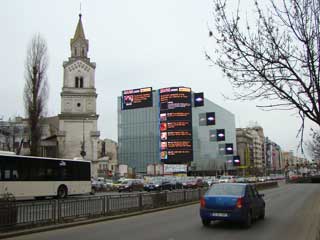 |
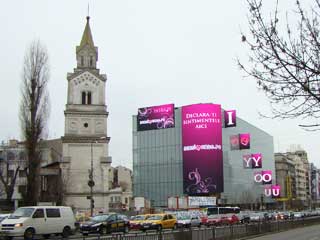 |
| LED screen media façade Cocor Shopping Center in Bucharest, Romania Photo: screens.ru |
|
Cocor Shopping Center Channel promo
Phoenix Island in China is another good example. Media façades were installed here on January 11, 2011 and immediately became a symbol of the modern China. New generation multifunctional video technology ensures that the lighting effects on building are spectacular and unforgettable.
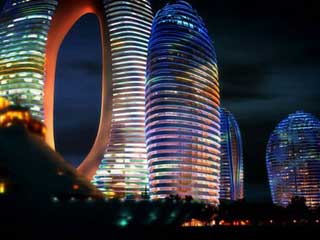 |
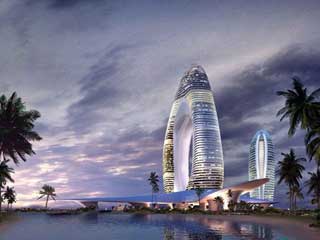 |
| Sanya Phoenix Island media façade with Daktronics ProPixel® LED stick elements Photo credit: designboom.com |
|
Media façade and digital signage as a merge of technologies: Technical and infrastructural advantages
Media façade is based on LED technology, semi conductors that transfer electrical current to multi colored light. Compared to other light sources an LED is better in light purity, wider color range, higher reliability, strength, higher efficiency, longer life (up to 100 thousand hours), power efficiency, higher level of fire safety and ecological safety. Hundred of thousand of LEDs are integrated into a huge media façade and display images and video programs. Unlike neon signs, light media façades practically cover the whole building and shape it’s new image during the evening hours.
Advertising messages on digital signage aim at a target audience at a specific time and place. Statistically, 70% of Americans pay attention to so called place-based video screens every month and 52% - every week. In four media campaigns out of five digital signage increases sales level by 33%. Not a bad parameter!
Who would argue that digital signage is much better than traditional static outdoor advertising? It’s dynamic, flexible, easily adjustable to client requirements, interactive etc.
Media façade and digital signage is an excellent illustration of the merge between architecture, marketing, IT and multimedia. They bring along new terminology such as mediatecture (media and architecture), digital marketing and a multitude of ideas for creative branding. Media façade and digital signage are gradually replacing the morally outdated advertising billboards and vinyl signs. Moscow is a typical megapolis overloaded with advertising. Naturally local authorities prohibit excessive use of billboards and banners, especially in downtown areas. Similar tendency is observed in all European cities. In these conditions, it’s natural to protect your investment, to invest shrewdly in digital advertising that has all the advantages of outdoor advertising, TV and informational terminal.
Dynamism and flexibility of digital signage makes this technology welcome in most trade centers around the world. Market experts believe that in 75% of cases consumers take a decision to buy unexpectedly at the point-of-sales. Is this not a good enough reason to saturate shop floor with dynamic digital screens that effectively target shoppers.
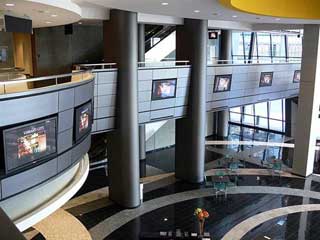 Digital signage in the World Market Center (Las Vegas)
Digital signage in the World Market Center (Las Vegas)Photo credit: digitalsignageexpo.net
In exhibition halls digital signage monitors are also welcome. Traditionally, exhibition ground is used for permanent exhibitions and promotional shows. Since exhibits constantly change and visiting audience belongs to ever changing groups, digital signage is the only solution that allows to reduce costs for constantly changing advertising content. A good example of digital advertising in exhibition complex is the World Market Center in Las Vegas.
The ever-growing service sphere is a potential customer for digital advertising systems. Thus, the scope for digital signage growth is tremendous.
Media façade is a new technology, a step forward compared to digital LED screens that by now have become permanent features in most cities. As LED technology matures, time has come for architects and manufacturers of LED applications to plan the future of our cities together.
Media façade offers indisputable visual advantages. But the financial side of the media façade projects is also essential. Properly planned and executed media façade and digital signage projects are profitable by default. Compared to traditional printed advertising methods, digital advertising is characterized by much faster return-on-investment (ROI) parameter, mostly due to easy and flexible control of content broadcasting.
In spite of young age, media façade and digital signage technology have already become accepted by most experts as a technology of the future. Who will dare to swim against this fast-current tendency?
Where to start and how to choose media façade?
Choosing media façade is a complex and costly process, so customers must avoid mistakes and pitfalls on the way. We will try to provide readers with a few useful pointers:
- First, look through a large portfolio of already completed media façade projects around the world. This will help understand variety and scale of the application.
- Clearly formulate requirements for the planned project. Take into account all possible limitations, structural, environmental, architectural, etc.
- Evaluate the media façade project from the point of view of an advertiser: viewing angles, distances, traffic and pedestrian flow etc.
- Once the financial plan is approved, start the first stage of design project - conceptual design.
- Formulate clearly the tasks for the planned media façade: architectural lighting, graphic or color effects, video commercials or slide show, samples of future content to be displayed, support of your company’s corporate image, calculation of advertising fees – all these factors are essential in the preliminary (pre-installation) phase.
- Do not forget about the possibility to announce a tender for the best conceptual design of your future project. Apart from the real tender you can run a virtual simulation tender on your web-site.
- Once the design was finalized, you may start thinking practical. During construction stage (that may be fairly long) you may think of installing on-site temporarily a fixed LED screen or rented screen to prepare people to the idea that this area will be offering digital advertising. The expenses will not “kill” the project, but will be useful in promoting your site while you are waiting for the completed digital façade.
- Time to develop detailed technical documentation and specifications.
- Having approved the plan with investors and city authorities, you may go into a second (easy) stage of placing the order for manufacturing and actually installing the media façade.
Seems easy but it is definitely not. There many factors that have to be considered and taken into account. Naturally, the assistance of a group of well-qualified experts is a must.
Main mistakes to be avoided
Even with a proper algorithm of action, customer always runs the risk of making typical mistakes. We hope you will avoid them if you look out to the following:
- Make sure that you understand the purpose and functions of the future media façade.
- Consider integration of your technology with architectural peculiarities of the building, closely follow the sequence of installation to avoid problems with construction.
- Choose the equipment to be installed (capable of your desired tasks) before the project goes into no-return phase to avoid frustrations and misunderstandings.
- Media façade is not a typical consumer product: all such projects are individual. Not every LED screen manufacturer is capable of building media façade. Do not buy equipment that may not be initially manufactured for these purposes.
- Do not forget about environmental considerations and climatic conditions. Some manufacturers do not have any idea how aggressive may be the environment in your climate zone.
- Select manufacturers and system integrators only based on their experience and their previously installed projects.
- While evaluating project cost and return-on-investment (ROI) consider high marketing potential of your future media façade – only in this case the high return is guaranteed.
As you see, choosing media façade and executing the project is not an easy task. But it’s worth it. It will make your project stand out, and make your city a nicer place to live in and to visit.





